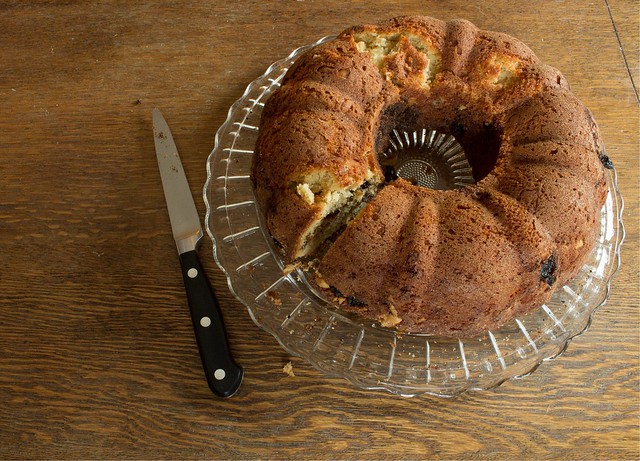It was funny that cake was the sourdough theme of the month for the Sourdough Surprises baking group. Just before the announcement, my Facebook friend (and all-around good, real food maven) Holly was talking about some amazing changes she made to a chocolate sourdough cake. It took me a few days to realize that the reason her cake looked so good and so familiar was because I had already made it - and changed it with similar results! I've said it before but it's true that it is a good thing that I have this space to write things down or I'd never remember half of what I've made.
The sourdough cake that we both loved was this one from King Arthur Flour. I had played around with it quite a bit (apparently, that was a year ago already), and then in my quest for not eating as much dessert, I let it go for too long a time. As Holly did, I had cut the sugar in half, but in my experiments this month, I used a different hydration sourdough starter - and both coconut and olive oils for the fat. The result was a moister version of that butter cake I made a year ago, and one that was not really high in sugar. Not counting the frosting, and allowing for 9 large slices in a 8x8 glass pan, I figure it around a tablespoon per serving.
I've been in full swing with Ken Forkish's breads - all of them turning out stellar, and I may be hooked on the 80% hydration starter that he calls for. I'm still figuring out the best feeding schedule for both my baking and waste reduction, but meanwhile, I'm turning 80% starter into all of my old favorites: crackers, cake and pancakes all turning out better than with my 100% liquid levain. The only thing I forgot about making this cake is that it takes some serious arm power (and lack of concern for gluten toughening) to incorporate the starter into a homogenized looking batter.
Don't be afraid to beat this cake until you are certain you have overbeaaten it, otherwise you may have traces of white sourdough bits in your chocolate cake, which you can't really taste, but they aren't as pretty. And a stand mixer might work, but avoid using a hand mixer... I learned the hard way that the batter tends to climb up the beaters and generally make a huge mess of things.
Chocolate Sourdough Cake (adapted from King Arthur Flour, with regard to Holly Langenburg, and my previous chocolate sourdough cake post)
makes one 8x8 inch cake
- 1/2 c. well-fed 80% sourdough starter (about 150 g.)
- 1/2 c. milk
- 1 c. AP flour
- 1/4 c. melted coconut oil
- 1/4 c. olive oil
- scant 1/2 c. sugar
- 1/2 t. salt
- 1 t. vanilla
- 6 heaping T. cocoa powder (natural process)
- 3/4 t. baking soda
- 1 egg
Combine
starter, milk and flour in a mixing bowl and let ferment. (KAF says at
least 3 hours, I ferment at least 8, and this particular cake fermented for 16. It's okay to leave it at room temperature during this fermentation time.) After ferment time, proceed:
Preheat oven to 350 degrees.
In a good sized bowl, mix the oils, sugar, and salt together well. Add the vanilla, cocoa powder, baking soda, and egg, and mix thoroughly.
Add the sourdough/milk/flour ferment to the chocolate-butter mixture. I found it easiest to use a sturdy spatula to mix the two - be firm but not vigorous and also be patient. Stir to combine until very few streaks of sourdough remain, and the batter looks like batter. It's sticky stuff!
Pour into a greased 8x8 glass baking dish, and use a metal knife or spatula dipped in water to spread batter evenly in the pan. The cake does "dome" a little, so you can try to push a bit more batter into the corners than into the center if this matters to you. Bake for 30-35 minutes until a tester in the center comes out clean.
You can use whatever frosting you like to top it after it cools completely - I just went with a simple American-style buttercream in a thin layer..
Preheat oven to 350 degrees.
In a good sized bowl, mix the oils, sugar, and salt together well. Add the vanilla, cocoa powder, baking soda, and egg, and mix thoroughly.
Add the sourdough/milk/flour ferment to the chocolate-butter mixture. I found it easiest to use a sturdy spatula to mix the two - be firm but not vigorous and also be patient. Stir to combine until very few streaks of sourdough remain, and the batter looks like batter. It's sticky stuff!
Pour into a greased 8x8 glass baking dish, and use a metal knife or spatula dipped in water to spread batter evenly in the pan. The cake does "dome" a little, so you can try to push a bit more batter into the corners than into the center if this matters to you. Bake for 30-35 minutes until a tester in the center comes out clean.
You can use whatever frosting you like to top it after it cools completely - I just went with a simple American-style buttercream in a thin layer..
Sourdough Lithuanian Coffee Cake.
I have made a number of cakes with sourdough starter - and also talked about them before. Most recently, I was excited about this Lithuanian Coffee Cake.
I also truly love this fully fermented Applesauce Cake, which uses a whole pint of home-canned applesauce and is based on a Spanish Bar Cake recipe my Gram used to make.
I'm fairly certain that sourdough cakes are not something I'm done experimenting with - and I'm sure I'll find plenty of links this month to convince me to consume a bit more sugar! Take a look below to check some of them out!


























